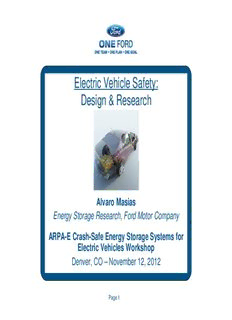
Electric Vehicle Safety: Design & Research - ARPA-e PDF
Preview Electric Vehicle Safety: Design & Research - ARPA-e
Electric Vehicle Safety: Design & Research Alvaro Masias Energy Storage Research, Ford Motor Company ARPA-E Crash-Safe Energy Storage Systems for Electric Vehicles Workshop Denver, CO – November 12, 2012 Page 1 Table of Contents Design Research Page 2 Table of Contents Design Research Page 3 Power of Choice ELECTRIFIED VEHICLES TRIPLING PRODUCTION CAPACITY IN NORTH AMERICA BY 2013 Page 4 Ford Focus Electric 110 MPGe Advanced Li-Ion Battery 5 PASSENGER 25-30% smaller LLIIQQUUIIDD--CCOOOOLLEEDD FASTER CHARGING 50% lighter 2233kkWWhh LLIITTHHIIUUMM--IIOONN BBAATTTTEERRYY PPAACCKK MORE EFFICIENT BATTERY TEMPERATURES Page 5 Reliability Researching and developing modern electrified vehicles for decades 1996 1998 2004 2009 2010 Cell Testing and Research Ford Escape Hybrid Ford Ranger Electric Ford Fusion Hybrid Page 6 Focus Electric Battery Location BEV Upper Battery Pack is mounted in the trunk behind the second row seats. Lower portion of pack extends through trunk floor to the outside of the vehicle BEV Lower Battery Pack is mounted under the vehicle below the second row seats Page 7 Crash Requirements – FMVSS 305 30mph Rigid Barrier 30mph 50mph 70% Overlap 30o Left & 33.5mph V-to-V Left & Right Left & Right Right 27o Crabbed Cart Angular Frontal Crash Events Side Crash Events Rear Crash Events Page 8 Public Domain & Additional Ford Crash Testing NCAP 20mph Oblique 35mph Left & Right Pole (5th/50th%) NCAP Rigid Barrier High Speed V-to-V Left & Right Rear 40mph 40% High Speed IIHS Offset V-to-V Left & Right Side 38.5mph NCAP Left & Right Side MDB 31mph Left IIHS Cart Page 9 FMEA Analysis Noise Factors & Potential Prevent Stress Failure Modes Effects Actions Normal Conditions Over Temperature No Effect Vehicle Level Design Actions Over Charge Protection Noise Factors Activated Pack Level Over Discharge Damage/ Design Actions Off-Normal Conditions External Short Retention Cell Level Internal Cell Short Leakage Design Actions Failure Modes Venting Fire/Flame Page 10
Description: